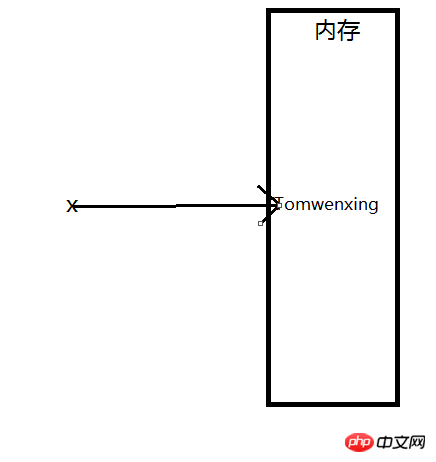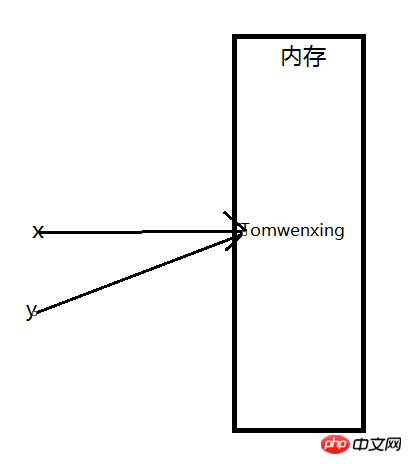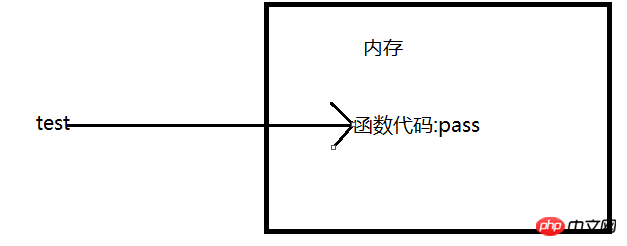Python decorator principle and usage analysis
This article mainly introduces the principle and usage of Python decorators, and analyzes the concepts, principles, usage methods and related operation precautions of Python decorators in the form of examples. Friends in need can refer to this article
Examples describe the principles and usage of Python decorators. Share it with everyone for your reference, the details are as follows:
1. The essence of the decorator is the function , which is mainly used to decorate other functions, that is, Add additional functions to other functions
2. Principles of decorators:
(1) Decorators cannot modify the source code of the decorated function
(2) Decorators cannot modify the calling method of the decorated function
3. Knowledge reserve for implementing decorators
(1) Functions in Python are 'variables'
a. Storage of variables in Python
x='Tomwenxing' y=x
[Explanation]:
##When the Python interpreter encounters the statement x='Tomwenxing' , it mainly completes two tasks:
## 1. Creates a space in the memory to store the string 'Tomwenxing'
2. Create a variable named x in the memory and use it to point to the memory space occupied by the string 'Tomwenxing' (can be understood as the room and room number Relationship)

That is, create a variable y in the memory and point it to the memory space pointed to by the variable x
 b. The function is in Storage in Python
b. The function is in Storage in Python
def test(): pass
In Python, the storage of functions is similar to variables. Take the above function as an example, Python explanation It mainly does two things:
1. Open up a memory space in the memory to store the string of the function code (in this example, the code has only one sentence: pass)
# 2. Create a variable test in the memory to point to the memory space where the function code string is stored(Equivalent to test='function body')

(2) Higher-order function (any one of the following two conditions is met to be a higher-order function)
a. Pass a function name as an actual parameter to another function
[Impact on decorators]: To achieve the effect of "adding functions to the decorated function without modifying its source code"import time
def bar():
time.sleep(2)
print('in the bar')
def test(func):
start_time=time.time()
func()
stop_time=time.time()
print('函数的运行时间为:',stop_time-start_time)
test(bar)
The running time of the function is: 2.0021145343780518b. The return value contains the function name
[Impact on decorators]: Achieve the effect of "not changing the calling method of the function"import time
def bar():
time.sleep(3)
print('in the bar')
def test2(func):
print('新添加的功能')
return func
bar=test2(bar)
bar()
in the bar(3) Nested function: Use def in a function body to declare a new function (not a call)
def foo():
print('in the foo')
def bar(): #声明一个新的函数,而不是调用函数
print('in the bar')
bar()
foo()Running result:
in the fooin the bar4. Decorator syntax: High-order function nested function => Decorator (the following example can use the pycharm debugger Debug it and see the running sequence of the code)
import time
def timer(func):
def deco(*args,**kwargs):#使用了不定参数
start_time=time.time()
res=func(*args,**kwargs) #运行函数
stop_time=time.time()
print('运行时间:',stop_time-start_time)
return res # 若无返回值,则返回None
return deco
@timer #等价于test1=timer(test1)=deco,即test1()=deco()
def test1():
time.sleep(3)
print('in the test1')
@timer #等价于test2=timer(test2)=deco,即test2(name)=deco(name)
def test2(name):
time.sleep(3)
print('in the test2',name)
test1()
print('-------------分界线------------------------')
test2('Tomwenxing')Running result:
in the test1Running time: 3.0001718997955322-------- -----Boundary line---------------------
5. Decorator with parameters
in the test2 Tomwenxing
Running time: 3.000171422958374
# -*- coding:utf-8 -*-
user,passwd='Tomwenxing','123'
#如装饰器带参数,一般是三层嵌套
def auth(auth_type): #第一层的参数是装饰器的参数
def outer_wrapper(func):#第二层的参数是装饰器要装饰的目标函数
def wrapper(*args,**kwargs):#第三次的参数是目标函数的参数
if auth_type=='local':
username = input('Username:').strip()
password = input('Password:').strip()
if user == username and passwd == password:
print('用户Tomwenxing已经成功登录!')
res = func(*args, **kwargs) #运行目标函数
return res
else:
exit('用户名或密码有错误')
elif auth_type=='ldap':
print('暂不支持这种登录方式!')
return wrapper
return outer_wrapper
def index():
print('欢迎来到index页面')
@auth(auth_type='local') #home=wrapper()
def home(name):
print('%s,欢迎来到home页面' %name)
return 'This is home page'
@auth(auth_type='ldap')
def bbs():
print('欢迎来到bbs页面 ')
index()
print('----------------------分界线-------------------')
print('函数的返回值为:',home('wenxing'))
print('----------------------分界线-------------------')
bbs()Running result:
Welcome to the index page------------ ----------Boundary line------------------Username:Tomwenxing
Password:123
User Tomwenxing has succeeded Log in!
wenxing, welcome to the home page
The return value of the function is: This is home page
----------------------Boundary line ------------------
This login method is not supported yet!
Related recommendations:
Use python decorator to calculate function running timePython iterator definition and simple usage analysisThe above is the detailed content of Python decorator principle and usage analysis. For more information, please follow other related articles on the PHP Chinese website!

Hot AI Tools

Undresser.AI Undress
AI-powered app for creating realistic nude photos

AI Clothes Remover
Online AI tool for removing clothes from photos.

Undress AI Tool
Undress images for free

Clothoff.io
AI clothes remover

Video Face Swap
Swap faces in any video effortlessly with our completely free AI face swap tool!

Hot Article

Hot Tools

Notepad++7.3.1
Easy-to-use and free code editor

SublimeText3 Chinese version
Chinese version, very easy to use

Zend Studio 13.0.1
Powerful PHP integrated development environment

Dreamweaver CS6
Visual web development tools

SublimeText3 Mac version
God-level code editing software (SublimeText3)

Hot Topics
 PHP and Python: Different Paradigms Explained
Apr 18, 2025 am 12:26 AM
PHP and Python: Different Paradigms Explained
Apr 18, 2025 am 12:26 AM
PHP is mainly procedural programming, but also supports object-oriented programming (OOP); Python supports a variety of paradigms, including OOP, functional and procedural programming. PHP is suitable for web development, and Python is suitable for a variety of applications such as data analysis and machine learning.
 Choosing Between PHP and Python: A Guide
Apr 18, 2025 am 12:24 AM
Choosing Between PHP and Python: A Guide
Apr 18, 2025 am 12:24 AM
PHP is suitable for web development and rapid prototyping, and Python is suitable for data science and machine learning. 1.PHP is used for dynamic web development, with simple syntax and suitable for rapid development. 2. Python has concise syntax, is suitable for multiple fields, and has a strong library ecosystem.
 Python vs. JavaScript: The Learning Curve and Ease of Use
Apr 16, 2025 am 12:12 AM
Python vs. JavaScript: The Learning Curve and Ease of Use
Apr 16, 2025 am 12:12 AM
Python is more suitable for beginners, with a smooth learning curve and concise syntax; JavaScript is suitable for front-end development, with a steep learning curve and flexible syntax. 1. Python syntax is intuitive and suitable for data science and back-end development. 2. JavaScript is flexible and widely used in front-end and server-side programming.
 PHP and Python: A Deep Dive into Their History
Apr 18, 2025 am 12:25 AM
PHP and Python: A Deep Dive into Their History
Apr 18, 2025 am 12:25 AM
PHP originated in 1994 and was developed by RasmusLerdorf. It was originally used to track website visitors and gradually evolved into a server-side scripting language and was widely used in web development. Python was developed by Guidovan Rossum in the late 1980s and was first released in 1991. It emphasizes code readability and simplicity, and is suitable for scientific computing, data analysis and other fields.
 Can vs code run in Windows 8
Apr 15, 2025 pm 07:24 PM
Can vs code run in Windows 8
Apr 15, 2025 pm 07:24 PM
VS Code can run on Windows 8, but the experience may not be great. First make sure the system has been updated to the latest patch, then download the VS Code installation package that matches the system architecture and install it as prompted. After installation, be aware that some extensions may be incompatible with Windows 8 and need to look for alternative extensions or use newer Windows systems in a virtual machine. Install the necessary extensions to check whether they work properly. Although VS Code is feasible on Windows 8, it is recommended to upgrade to a newer Windows system for a better development experience and security.
 Can visual studio code be used in python
Apr 15, 2025 pm 08:18 PM
Can visual studio code be used in python
Apr 15, 2025 pm 08:18 PM
VS Code can be used to write Python and provides many features that make it an ideal tool for developing Python applications. It allows users to: install Python extensions to get functions such as code completion, syntax highlighting, and debugging. Use the debugger to track code step by step, find and fix errors. Integrate Git for version control. Use code formatting tools to maintain code consistency. Use the Linting tool to spot potential problems ahead of time.
 How to run python with notepad
Apr 16, 2025 pm 07:33 PM
How to run python with notepad
Apr 16, 2025 pm 07:33 PM
Running Python code in Notepad requires the Python executable and NppExec plug-in to be installed. After installing Python and adding PATH to it, configure the command "python" and the parameter "{CURRENT_DIRECTORY}{FILE_NAME}" in the NppExec plug-in to run Python code in Notepad through the shortcut key "F6".
 Is the vscode extension malicious?
Apr 15, 2025 pm 07:57 PM
Is the vscode extension malicious?
Apr 15, 2025 pm 07:57 PM
VS Code extensions pose malicious risks, such as hiding malicious code, exploiting vulnerabilities, and masturbating as legitimate extensions. Methods to identify malicious extensions include: checking publishers, reading comments, checking code, and installing with caution. Security measures also include: security awareness, good habits, regular updates and antivirus software.






